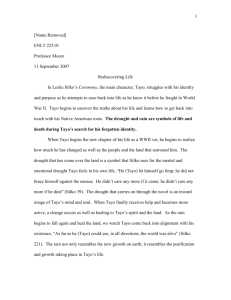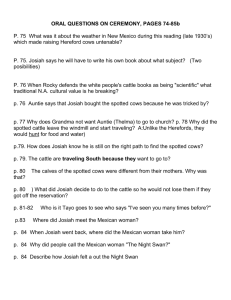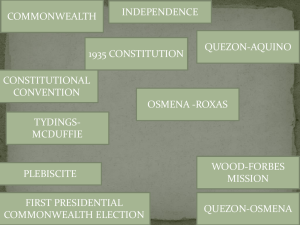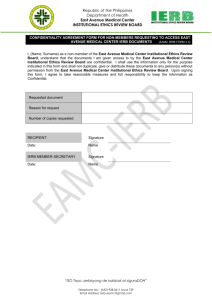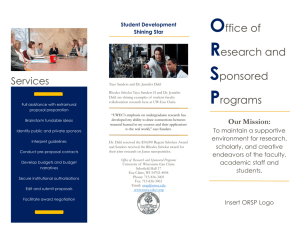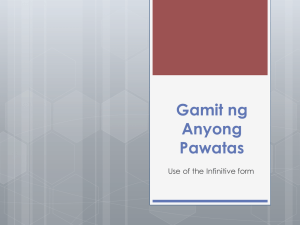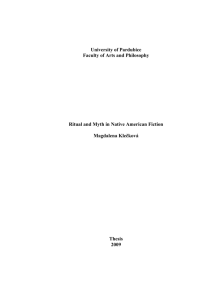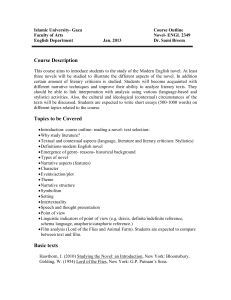literary analysis data sheet
advertisement
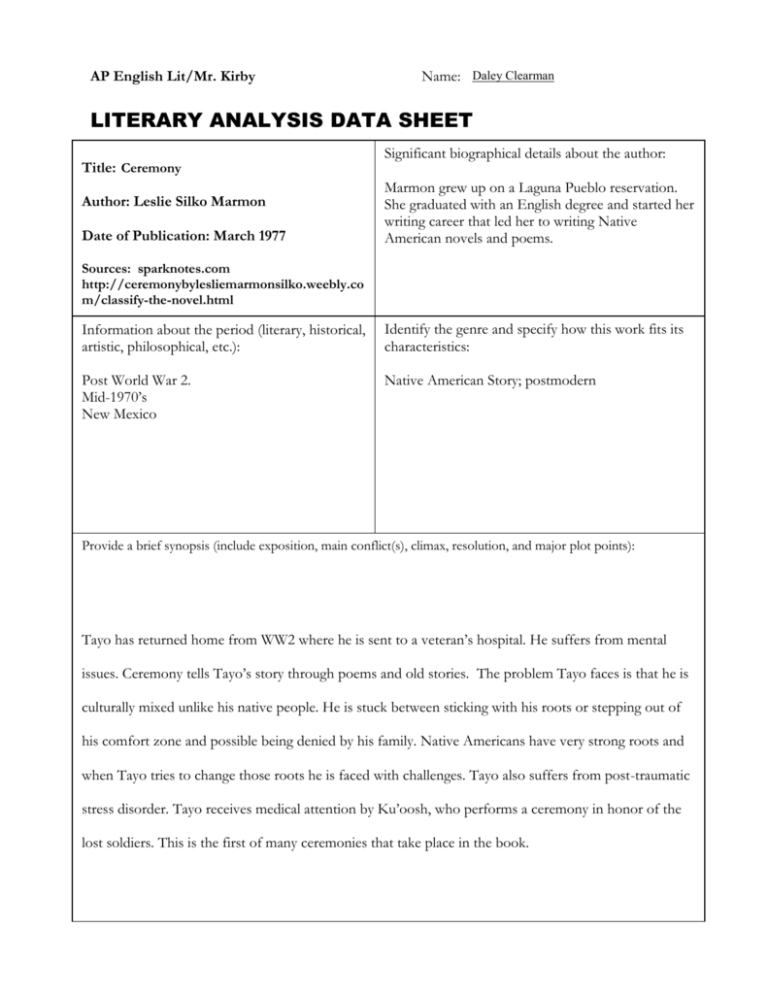
AP English Lit/Mr. Kirby Name: Daley Clearman LITERARY ANALYSIS DATA SHEET Title: Ceremony Author: Leslie Silko Marmon Date of Publication: March 1977 Significant biographical details about the author: Marmon grew up on a Laguna Pueblo reservation. She graduated with an English degree and started her writing career that led her to writing Native American novels and poems. Sources: sparknotes.com http://ceremonybylesliemarmonsilko.weebly.co m/classify-the-novel.html Information about the period (literary, historical, artistic, philosophical, etc.): Identify the genre and specify how this work fits its characteristics: Post World War 2. Mid-1970’s New Mexico Native American Story; postmodern Provide a brief synopsis (include exposition, main conflict(s), climax, resolution, and major plot points): Tayo has returned home from WW2 where he is sent to a veteran’s hospital. He suffers from mental issues. Ceremony tells Tayo’s story through poems and old stories. The problem Tayo faces is that he is culturally mixed unlike his native people. He is stuck between sticking with his roots or stepping out of his comfort zone and possible being denied by his family. Native Americans have very strong roots and when Tayo tries to change those roots he is faced with challenges. Tayo also suffers from post-traumatic stress disorder. Tayo receives medical attention by Ku’oosh, who performs a ceremony in honor of the lost soldiers. This is the first of many ceremonies that take place in the book. Literary Analysis Data Sheet page 2 Identify and explain the use and effect of three literary techniques: 1. Flashbacks- throughout the novel Tayo has flashbacks that explain to the read why he is suffering from post traumatic stress disease. 2. Symbolism- many things symbolize different things in the book. An example is Rocky. He symbolizes hope. 3. Allegory- old stories are told through allegories all throughout the book. Cite and quote one example of each: 1. "The teeth sucked up the light, and darkness closed around Tayo with an ambush of voices in English and Japanese" (Silko 62). 2. "He went back to reading his book. He did not hesitate to speak like that, to his father and his uncle, because the subject was books and scientific knowledge-those were the things that Rocky had learned to believe in" (Siko 76). 3. "So anyway they all got together witch people from all directions witches from all the Pueblos and all the tribes..." (Silko 133). Significant Quotes Cite and quote three significant passages: 1. 2. 3. “Jungle rain had no beginning or end; it grew like foliage from the sky, branching and arching to the earth, sometimes in solid thickets entangling the islands, and, other times, in tendrils of blue mist curling out of coastal clouds. The jungle breathed an eternal green that fevered men until they dripped sweat the way rubbery jungle leaves dripped the monsoon rain. It was there that Tayo began to understand what Josiah had said. Nothing was all good or all bad either; it all depended.” “The word he chose to express "fragile" was filled with the intricacies of a continuing process, and with strength inherent in spider webs woven across paths through sand hills where early in the morning the sun becomes entangled in each filament of web. It took a long time to explain the fragility and intricacy because no word exists alone, and the reason for choosing each word had to be explained with a story about why it must be said this certain way. That was the responsibility that went with being human, old Ku'oosh said, the story behind each word must be told so there could be no mistake in the meaning of what had been said; and this demanded great patience and love.” “Here they were, trying to bring back that old feeling, that feeling they belonged to America the way they felt during the war. They blamed themselves for losing the new feeling; they never talked about it, but they blamed themselves just like they blamed themselves for losing the land the white people took. They never thought to blame the white people for any of it; they wanted white people for their friends. They never saw that it was the white people who gave them that feeling and it was the white people who took it away again when the war was over.” Explain the significance of each passage or explain how it relates to the work as a whole: 1. One of the most important lessons Tayo learns in the course of the novel is that everything has both its positive and its negative aspects. This moment of realization comes early in the novel, as Tayo, newly returned to the reservation, remembers the most traumatic moments of his service in World War II, which include Rocky's death. 2. Tayo returns home from the war both sick with malaria and deeply troubled on an emotional level. His stay at the Veteran's Hospital does little to help with the latter problem. Once home, as soon as he is well enough to get out of bed, Tayo's Grandma arranges for him to see the medicine man, Ku'oosh. Ku'oosh begins his ceremony by repeating to Tayo the names and locations of the places that are sacred to the Laguna, and the basis of their understanding of the world. With Spider Woman as one of the most important figures in Pueblo mythology, the metaphor of the web is most appropriate for describing their world-view. Throughout the novel, animals and plants serve as symbols of the deep connection the Pueblo people have with the natural world. 3. After they return to the reservation, the young men who fought in World War II often meet at the bars on the reservation line to drink and reminisce. After drinking at the bar, true feelings come out and we see a side of Emo that Tayo does not like. Emo shows racism and Tayo stands up for what he believes. Literary Analysis Data Sheet page 3 Characters Record information for each significant major character in the work Name Role in the story Significance or Purpose Adjectives World War 2 veteran 1. Tayo Main Character Tayo has a lot of culture. He has great difficulty in negotiating his mixed identity and experiences. Tayo serves as a bridge between the older and younger generation. 2. Betonie Medicine man Bridges the real and mythical worlds. Spends much of his time communicating with spirits and stories. Tayo tries to makes sense of the world, Betonie was raised with a deep understanding of it. Where Tayo cries, Betonie laughs. 3. Auntie Tayo’s aunt In charge of running the household and taking care of the family. She has raised Tayo from age four. She is the one the sends Tayo to see Ku’oosh. Christian Responsible Care-taker Tayo’s adoptive brother Rocky dies during the war, which is a big part of Tayo’s disease. Integrated perfectly into white society 4. Rocky(Tayo’s cousin) Kindred spirit to Tayo Wise faith advisor Literary Analysis Data Sheet Describe the setting(s) and explain its/their significance: The story takes place in Laguna Pueblo on an Indian reservation. This is very important to the story because Tayo is just returning back to the reservation from war. The reservation is where he finds his roots and his healing from post-traumatic stress disorder. Identify and explain key metaphors, symbols, or motifs: 1. Nonlinear Narrative Structure- Silko switches back and forth from Tayo’s childhood to his time in the Philippines to various moments after his return, following no order. The entire novel is narrated in the past tense, so whether an event actually occurred before Tayo’s birth or in the midst of the ceremony, it appears to happen at the same time. page 4 Identify and explain the theme(s) of the work: 1. The importance of storytelling- native American tradition of storytelling 2. Contact between cultures- native American and white cultures. Mixed cultural landscape that allows Native Americans to persist. 3. Importance of tradition- saving the Native American community. 2. The Combination of Poetry and Prose- By combining poetry and prose in her novel, Silko asserts that the form as well as the content of the story is about the blending of the two cultures. 3. The Gallup Ceremonial- he Gallup Ceremonial symbolizes the ways in which whites misunderstand Native American tradition and appropriate it for their own purposes. Write at least three questions or topics for class discussion: 1. 2. 3. What kind of traditions do we as Americans hold that Native Americans find so important in their culture? In the book Tayo suffers from post-traumatic stress. How do they handle it that is different from modern day medicine? How does the use of allegory affect the mood of the book?
